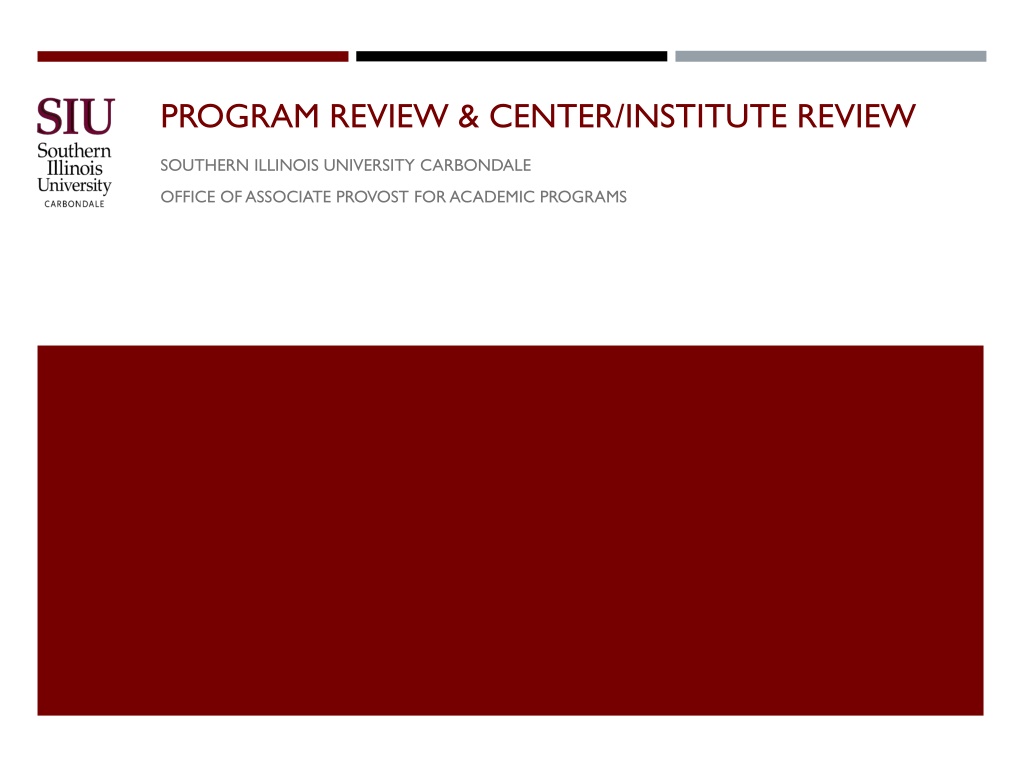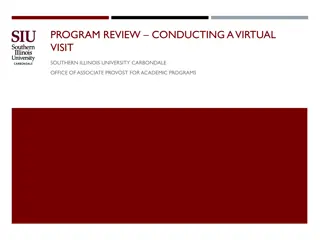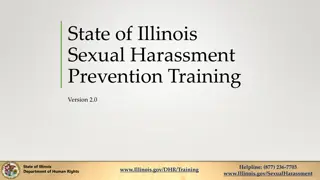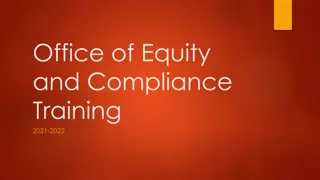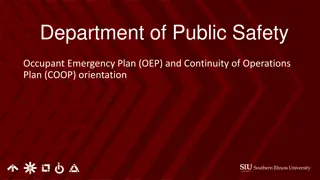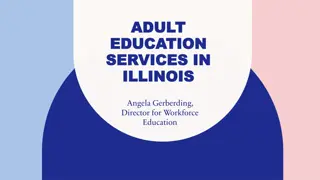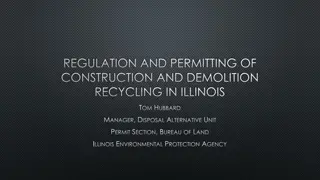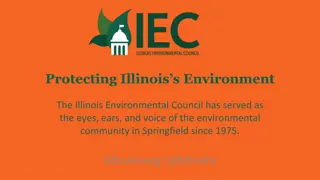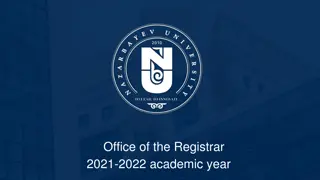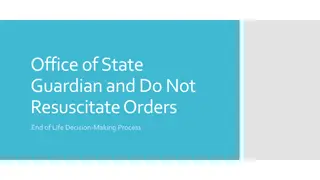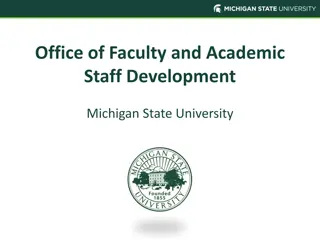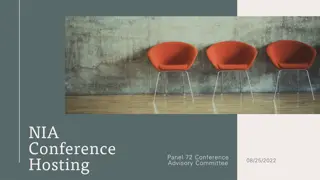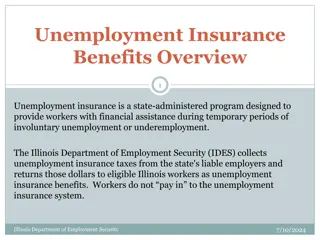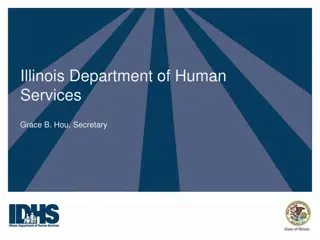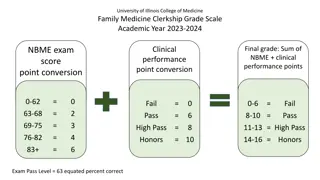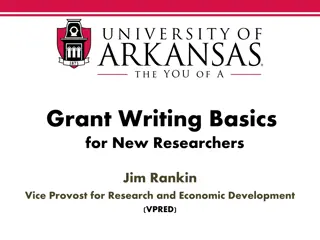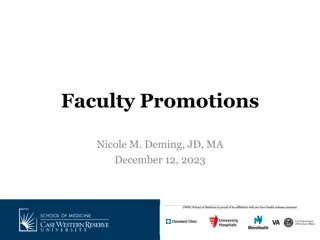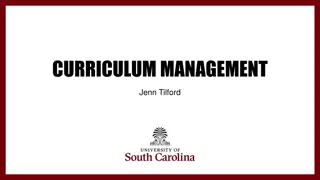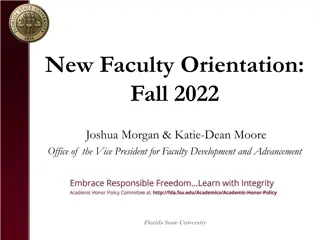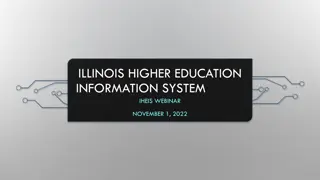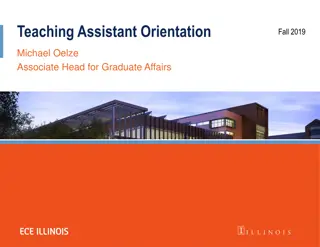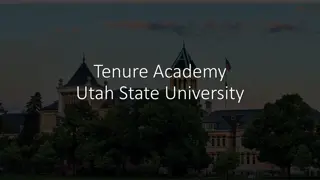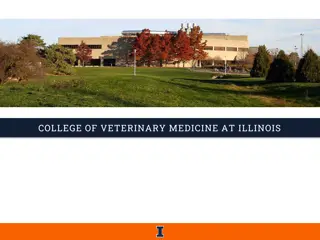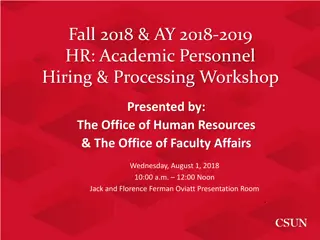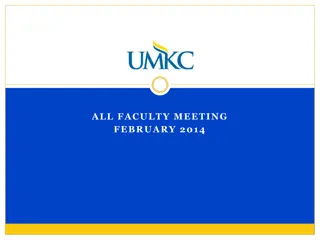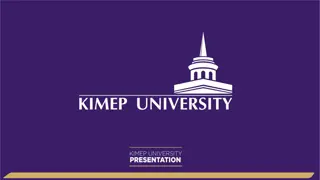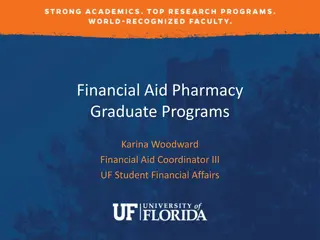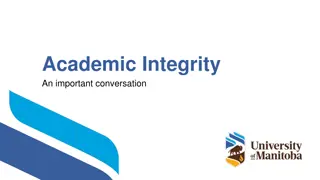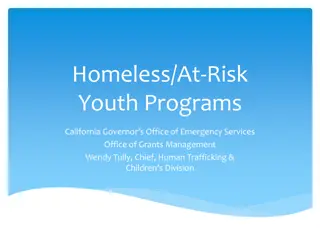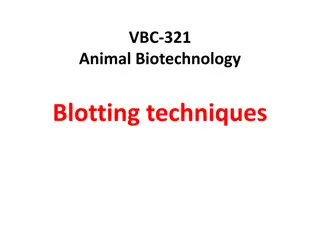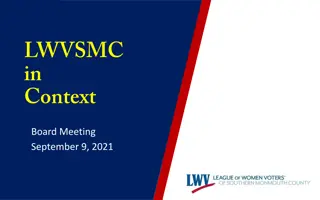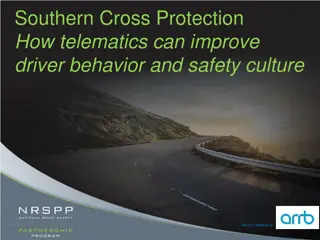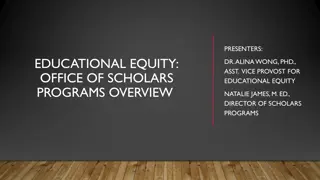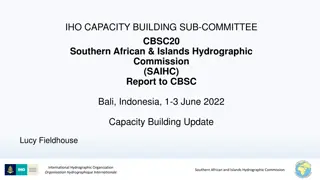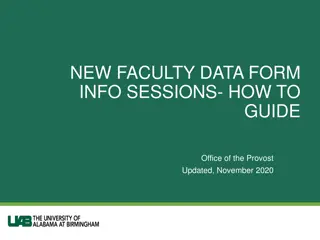Southern Illinois University Carbondale Office of Associate Provost for Academic Programs Review
The Program Review & Center/Institute Review at Southern Illinois University Carbondale aims to educate attendees on IBHE requirements, the review process, conflict of interest policies, self-study writing, on-site review involvement, financial support, and available resources. The IBHE mandates reviews every eight years, with exceptions for new programs and degree-specific accreditations. Detailed processes and timelines ensure a comprehensive evaluation and continual program improvement.
Download Presentation

Please find below an Image/Link to download the presentation.
The content on the website is provided AS IS for your information and personal use only. It may not be sold, licensed, or shared on other websites without obtaining consent from the author. Download presentation by click this link. If you encounter any issues during the download, it is possible that the publisher has removed the file from their server.
E N D
Presentation Transcript
PROGRAM REVIEW & CENTER/INSTITUTE REVIEW SOUTHERN ILLINOIS UNIVERSITY CARBONDALE OFFICE OF ASSOCIATE PROVOST FOR ACADEMIC PROGRAMS
LEARNING OUTCOMES At the end of this tutorial/workshop, attendees will: Be cognizant of IBHE s requirement for program review Have a working knowledge of the process used for program review at SIUC Be informed of the State of Illinois policy governing conflict of interest regarding the nomination of program reviewers Be informed about writing a self-study Consider the different constituencies that could be involved with the on-site review Be cognizant of the financial support available through the APAP office Have a working knowledge of resources available through APAP website Have access to all final reports for the campus and system
IBHE REQUIREMENT FOR A REVIEW The Illinois Board of Higher Education (IBHE) requires each degree program be reviewed on an eight-year cycle (https://www.ibhe.org/assets/files/ProgramReviewGuidelines.pdf) Exceptions to this requirement are new programs, which are reviewed three years after approval. Degree-specific accreditations meet the requirement of the IBHE-mandated review provided that they are reviewed at least every eight years.
IBHE REQUIREMENT FOR A REVIEW 5.1 Description and assessment of any major changes in the program [e.g., (a) changes in the overall discipline or field; (b) student demand; (c) societal need; (d) institutional context for offering the degree; (e) other elements appropriate to the discipline in question; and (f) other]. 5.2 Description of major findings and recommendations, including evidence of learning outcomes and identification of opportunities for program improvement; 5.3 Description of actions taken since the last review, including instructional resources and practices, and curricular changes; and 5.4 Description of actions to be taken as a result of this review, including instructional resource and practices, and curricular changes.
OVERVIEW OF PROCESS Parallels processes used for accreditation Start Select Reviewers Reviewers Report Dean s Report IBHE Report Site Visit Self Study Self Study is due to APAP by August 15th Submit Names of Reviewers Spring Semester Site Visit Prior to Following March
TIMELINE FOR CENTER/INSTITUTE REVIEW Submit Reviewers Names to APAP: April 15 Submit Self-Study Report to APAP: August 15 Submit Self-Study Report to Reviewer: September Schedule Virtual Meetings (if needed): September - November. Reviewer s Report Due: First week of December Meeting to discuss Results: December - February Compile all review reports and submit to System s Office: Summer
SELECTION OF REVIEWERS Programs/Centers/Institutes submit nominations of external and internal reviewers, including alternates, to the APAP office. The nominations are approved by Faculty Senate and Graduate Council. Please discuss with the APAP office if you think you might need more than one external reviewer. According to the State Officials and Employees Ethics Act (5 ILCS 430/), units must avoid nominating reviewers with potential bias or conflicts of interest with the program or its faculty. Current or former collaborators, colleagues, mentors, and students, faculty and staff of unit are inappropriate, as are past reviewers of the unit. If you have any questions about possible conflicts of interest, contact the APAP (453- 7653).
PROGRAMS: WRITING THE SELF-STUDY Assessment plans are submitted mid-cycle (year 4) Mission Statement Program Goals Assessment Plan Program Student Learning Outcomes Assessment Tools/Baseline Action Plan Self-Study Strategies for addressing SLO below baseline Cycle used for assessment Involvement of constituencies Assessment Report Assessment reports are submitted annually Assessment of SLO Curriculum or Program Changes Changes in Faculty or Administration Appendix Cost study data Enrollment, graduation and placement data Assessment tools or rubrics used
CENTERS/INSTITUTES: WRITING THE SELF-STUDY Annual reports are submitted to the Office of the Vice Chancellor for Research Brief overview of program Advisory board Performance measures Annual Reports Self-Study Changes since last review Organizational effectiveness Major activities Revenue and annual expenditures Facilities
PROGRAMS: WRITING THE SELF-STUDY Overview Provide a brief overview of the program (e.g., the year the program was started, the number of faculty and staff, delivery methods, other degrees offered in the school). Provide an overview of how the student learning outcomes map to the program goals, which in turn map to the program and university mission. Mission: Depending on the structure of your academic unit, the mission may be at the school level. Goals: Depending on the structure of your academic unit, the goals may be at the school level. Student Learning Outcomes: The student learning outcomes should be at the program level.
PROGRAMS: WRITING THE SELF-STUDY Points of Pride In this section, provide rankings, awards, or notable scholarship and achievements of your faculty, program, and students. Overview of Assessment and Continuous Improvement Provide an overview of the assessment and continuous improvement process that includes: Assessment tools used Timeline of assessment Constituencies involved (faculty, students, graduates, employers, and/or advisory boards) Mapping of program goals, student learning outcomes, and curriculum (this is a required component your program s required assessment plan) Assessment of on-line/off-campus courses (if applicable)
PROGRAMS: WRITING THE SELF-STUDY Curriculum and Program Changes Since Last Program Review Include a summary of the assessment data supporting these changes. Faculty List of faculty, including NTT Identify area of expertise and courses taught over last academic year. Report changes in faculty since last review (tenure, promotion, resignation/retirement, new hires, etc.). Provide an overview of the impact of these changes.
PROGRAMS: WRITING THE SELF-STUDY Research, Scholarship and Creative Activities Report and analyze recent three years (at a minimum). Programs are encouraged to use Activity Insight. The Office of the Vice Chancellor for Research provides support and access to this platform. Cost Study Data Data will be provided by the APAP office. Enrollment, Graduation, and Placement Data Report and summarize recent three years (at a minimum). Enrollment and graduation data: Interactive Factbook (https://irs.siu.edu/interactive-factbook/) Placement data is from various sources depending on the program (exit interview, LinkedIn, SIUC Career Services)
PROGRAMS: WRITING THE SELF-STUDY Surveys and Questionnaires Report and analyze the results of Student Exit Surveys, Alumni Surveys and/or Employer Surveys (including internships and co-op). How have the results been used for continuous improvement of the program? Facilities Briefly describe teaching labs, studios, and classrooms. Are there special features that are unique to the program? Are the facilities adequate? Does the program have a plan in place for acquiring new equipment, maintaining current facilities, or improving the student learning environment?
PROGRAMS: WRITING THE SELF-STUDY Online Programs This is an optional section for programs that have degree programs offered online. Briefly describe the online program. Provide data on enrollment and graduation (this can be included in previous section if the data for on campus and online is parsed). At a minimum, address the following questions: Does the online degree program have the same SLO as the on-campus program? Does the assessment process for the program include assessment of online programs? Is student advisement for online students adequate? How are laboratory components offered (if applicable)?
PROGRAMS: WRITING THE SELF-STUDY Off-Campus Programs This is an optional section for programs that have degree programs offered off campus. Briefly describe the off-campus program. Provide data on enrollment and graduation (this can be included in previous section if the data for on campus and online is parsed). At a minimum, address the following questions: Does the off-campus degree program have the same SLO? Does the assessment process include the off-campus programs? Is there a process for determining faculty qualifications? Is student advisement adequate? Are the facilities adequate?
PROGRAMS: WRITING THE SELF-STUDY Summary Describe the program s plan for future growth and improvement in the next eight years (including but not limited to curricular, research, facilities, faculty recruitment and development, student recruitment and retention, diversity goals). What opportunities exist to extend and build on the present strengths? What are the major obstacles?
PROGRAMS: WRITING THE SELF-STUDY Appendix Faculty Curriculum Vitae (2-pages per faculty) Catalog Copy Previous Program Reviewers Report Current Assessment Plan Assessment Reports (minimum last three years) Strategic Plan: If online, provide a link. Best practice is to revise strategic plans every five to eight years. Department or School Operating Paper: If online, provide link. Program Promotional Material (optional): If online, provide link.
CENTERS/INSTITUTES: WRITING THE SELF-STUDY Annual Report Self-Study Centers and Institutes are required to submit an annual report to the Office of the Vice Chancellor for Research. The annual reports provide information required in the self-study. If these are up-to- date, the time to prepare the self-study is reduced. Centers and Institutes are advised to begin the self-study in the spring term prior to the review since it is due in the APAP Office by August 15.
CENTERS/INSTITUTES: WRITING THE SELF-STUDY The major elements of the Center/Institute self-study are: Brief overview of program Advisory board Performance measures Changes since the last review Organizational effectiveness Major activities Revenue and annual expenditures Facilities
CENTERS/INSTITUTES: WRITING THE SELF-STUDY The appendix to the self-study report will include: Faculty curriculum vitae (2-pages per faculty) Previous reviewer s report and recommendations Strategic plan Annual reports Center/Institute management plan
PREPARING FOR THE SITE VISIT Self-study is submitted to APAP office by August 15. After APAP review and feedback, the program provides the final self-study to the program reviewers. A copy of the self-study should also be shared with the program faculty. Prepare the site visit itinerary. For academic programs, as early as possible get multiple reviewer availability dates and check them against the Provost s availability. The Provost s schedule fills quickly. For centers and institutes, as early as possible get multiple reviewer availability dates and check them against the Vice Chancellor for Research s availability. For programs and centers in the School of Medicine, as early as possible get multiple reviewer availability dates and check them against the SOM Dean and Provost.
SITE VISIT ITINERARY The program administrative unit is responsible for developing the itinerary. Meetings should be scheduled with: Day One 8:00 Event Initial Team Meeting: Breakfast Location Escort Internal Reviewers 9:00-9:30 Reviewers meet with APAP and College Dean to review charge Dean or APAP conference room 9:30 10:00 10:30 11:00 11:30 12:00 Dean of College Provost and Vice Chancellor for Academic Affairs (3-7648) Lunch meeting with students (up to 6 students) Provide names. If applicable: 1:00 2:00 3:00 4:00 5:00 6:00 Day Two 9:00 10:00 11:00 12:30 Vice Chancellor for Research (3-4551) Extended Campus (3-4033) Return to hotel Review Team Dinner University Core Curriculum (6-5555) Dean of the Library (3-2522) Working lunch for reviewers to discuss preliminary findings Center for Teaching Excellence (3-2258) 1:30 Exit meeting for review team with APAP and College Dean Dean or APAP conference room Include time for reviewers to tour facilities 2:00 Escort to hotel or airport FINAL REPORT DUE WITHIN ONE MONTH
SITE VISIT The purpose of the on-site review is to verify the evidence provided in the self-study. This is primarily done through interviews with a range of constituencies: Faculty Students Provost Dean Vice Chancellor for Research Advisory board Collaborative or support programs Tours of facilities (for virtual reviews: virtual, videos, labelled pictures)
REVIEWERS REPORT Overview Unique or innovative approaches to teaching, learning, or new knowledge creation Program Assessment Are faculty involved with and aware of the content of the self-study? Does the process for defining the mission, goals, and SLOs involve internal or external constituencies other than faculty? Are the benchmarks (baselines) and assessment tools appropriate for determining the achievement of SLOs? Is assessment used for continuous improvement? Classrooms, Facilities and Laboratories Online/off campus programs Leadership and Institutional Support Recommendations
IBHE REQUIREMENT FOR A REVIEW REPORT FROM DEAN 5.1 Description and assessment of any major changes in the program [e.g., (a) changes in the overall discipline or field; (b) student demand; (c) societal need; (d) institutional context for offering the degree; (e) other elements appropriate to the discipline in question; and (f) other]. 5.2 Description of major findings and recommendations, including evidence of learning outcomes and identification of opportunities for program improvement; 5.3 Description of actions taken since the last review, including instructional resources and practices, and curricular changes; and 5.4 Description of actions to be taken as a result of this review, including instructional resource and practices, and curricular changes.
FINAL CAMPUS REPORT SIU Systems Office APAP IBHE SIU System Program Quality Assurance Report siusystem.edu/academic-affairs/reports.shtml
EXPENSES: APAP FUNDED Total to be spent on each review for travel, lodging, and meals is $1,000. Additional funds will be provided by the APAP office, if an additional external reviewer is approved. Reimbursement to the academic unit requires submission of all paperwork to APAP office within 7 days of the program review completion. If expenses exceed $1,000, the academic unit will need to cover additional expenses out of their own budgets.
EXPENSES: HONORARIUM External Reviewer Honorarium = $250 Honorarium should be submitted once the APAP office has approved the External Reviewer s Report. The academic unit prepares the documents: Invoice Distribution Form, Independent Contract Analysis Form, and W-9 Form. Obtain the reviewers signatures on these forms before they depart from campus. Internal Reviewers do not receive an honorarium from the APAP.
EXPENSES: TRAVEL ARRANGEMENTS Units make travel arrangements for external reviewers. Use the P-card to cover these costs: Airfare for a non-refundable, economy seat An Enterprise Rental Car can be arranged through SIU Travel Service for pick-up/drop-off at St. Louis Lambert Airport. Lodging
EXPENSES: LODGING ARRANGEMENTS According to SIU Travel Regulations Use either the Hampton Inn or Home2 Suites by Hilton in Carbondale. Request the in-state rate ($75) when making the reservation. Units must use the SIU P-card to receive the discounted rate. Room service and alcohol are not covered.
EXPENSES: MEALS All meals are covered for internal and external reviewers (per diem rates). No additional guests, other than students at a student luncheon. The APAP office will fund up to $100 for a student luncheon. Alcohol is not covered. Ask reviewers to turn in all receipts prior to departure. Meal receipts must be itemized. Per University expense guidelines, meals require an Entertainment Expense Documentation (EED) form approved in advance. The academic unit submits draft EED to apap@siu.edu at the minimum of two weeks prior to the scheduled review. All meals for the program review are to be included on one form. The APAP office obtains signatures and returns the approved EED form to the academic unit. For each meal, the academic unit needs to submit the P-card Transaction Request form, itemized receipt,and EEDform.
EXPENSES: CAMPUS FORMS Invoice Distribution Form: https://eforms.siu.edu/siuforms/info/acp0302.php Independent Contract Analysis Form: https://eforms.siu.edu/siuforms/forms/hro1070.pdf W-9: https://procurement.siu.edu/_common/documents/forms/w9.pdf Entertainment Expense Documentation Form: https://eforms.siu.edu/siuforms/forms/prc0400.pdf
ON-LINE RESOURCES APAP WEBSITE Assessment plan template Assessment report template Program Resources Self-Study Template Itinerary Template Program Review Expense Guidelines Suggested Guidelines for Faculty CV (short form) Reviewer Resources Sample Reviewer Questions Reviewer Report Template Dean Resources IBHE Program Review Form Tutorials https://pvcaa.siu.edu/associate- academic-programs/program-review/
LEARNING OUTCOMES At the end of this tutorial/workshop, attendees will: Be cognizant of IBHE s requirement for program review Have a working knowledge of the process used for program review at SIUC Be informed of the State of Illinois policy governing conflict of interest regarding the nomination of program reviewers Be informed about writing a self-study Consider the different constituencies that could be involved with the on-site review Be cognizant of the financial support available through the APAP office Have a working knowledge of resources available through APAP website Have access to all final reports for the campus and system
CONTACTS/QUESTIONS Office of Associate Provost for Academic Programs 453-7653 apap@siu.edu
